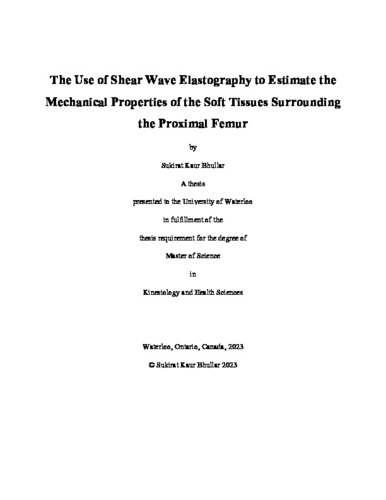| dc.description.abstract | Introduction: Falls are the leading cause of injury, morbidity, and mortality amongst older adults nationally and worldwide, with 95% resulting in hip fractures. Previous studies have found that the soft tissues (subcutaneous adipose and muscle) surrounding the proximal femur influence the magnitude and distribution of the impact force transmitted to the underlying bone during an impact, and thus hip fracture risk. However, there is a gap in the literature since studies have not explored the role of the soft tissues’ mechanical properties, particularly Young’s modulus, on the impact force magnitudes and distribution during both resting and muscle contracted states. This gap can be addressed using shear wave elastography (SWE), an ultrasound imaging technique that quantifies soft tissues' shear wave velocity (SWV). SWV can be used to compute the Young’s moduli of the tissues and gain a better understanding of the mechanical properties of the tissues. Investigating the SWV of the soft tissues would help improve the biofidelity of physical and computational hip models, which would allow us to better understand lateral fall impact dynamics and help to improve the design of hip fracture prevention technologies.
Objectives and Hypotheses: There were two main objectives of this thesis. The first objective was to evaluate the intra-rater reliability of the SWE protocol used to characterize the SWV of the soft tissues (subcutaneous adipose and muscle) in the lateral-hip region, and the potential influence of muscle contraction on intra-rater reliability. The second objective was to assess the influence of muscle contraction on the soft tissues’ SWV. Based on the previous literature, it was hypothesized that: 1) the intra-rater reliability of the subcutaneous adipose and muscle SWV measurements taken with this protocol would range from good to excellent (ICC > 0.75), and would not be influenced by contraction state, and 2) there would be an interaction effect of muscle contraction on the SWV magnitudes of the soft tissues. It was expected that: a) the muscle SWV magnitude would be greater during the muscle contracted state compared to the resting state, while b) the subcutaneous adipose SWV magnitude would not change during the resting and muscle contracted states.
Methods: Twenty healthy, young adults between the ages of 18-35 years with a BMI ≤ 24.9 kg/m2 were recruited. The elastography setting on the GE LOGIQ E10 commercial ultrasound machine and a linear probe were used to take 3 measurements of the muscle and subcutaneous adipose tissues from a marked location on the participants’ left lateral hip region. Three measurements from each tissue were taken during the muscle relaxed and contracted states, resulting in 12 measurements being collected from each participant. A two-way mixed effects absolute agreement intraclass correlation (ICC) model was used to assess the intra-rater reliability of the measurements and the influence that muscle contraction had on it. A two-way repeated measures analysis of variance (ANOVA) was used to assess the potential interaction effect of muscle contraction on the SWV magnitudes of the soft tissues.
Results: As hypothesized the intra-rater reliability of the subcutaneous adipose and muscle tissues ranged from good to excellent (0.81 < ICC < 0.95) and was not influenced by contraction state. This aligned with previous literature and supported that the protocol was appropriate for examining the influence of muscle contraction on SWV (Objective 2). Two-way repeated measures ANOVA revealed a significant interaction effect of muscle contraction on the SWV magnitudes of the soft tissues (p < 0.05), which was particularly driven by the significant increase in the muscle’s SWV from resting to contracted state (p < 0.001). In contrast, the subcutaneous adipose’s SWV was not different during the two conditions (p = 0.825). These results aligned with the hypothesis and indicated that the moduli of the soft tissues in this region respond differently between relaxed and contracted states.
Discussion and Conclusion: The protocol used in this thesis had good to excellent intra-rater reliability and can be used to characterize the moduli of the soft tissues in additional locations in the hip region. Additionally, the influence of BMI and aging on the stiffness of the soft tissues in this region can also be investigated. Muscle contraction also influenced the SWV of the muscle, while the SWV of the subcutaneous adipose did not change. This finding indicates that the soft tissues in the hip have unique properties and respond differently to muscle contraction. Accordingly, it is worth exploring whether they should be modelled separately in biomechanical models of the hip and pelvis. Implementing this finding in physical and computational models that currently bulk together the properties of the soft tissues in the hip, should improve their biofidelity. Additionally, the protocol used in this thesis, along with the differences observed in the soft tissues’ SWV, can potentially be used to assess muscle quality. Since alternative modes on the ultrasound, such as echo intensity, are currently used to assess changes in muscle quality, SWE may be an alternative technique that can be used. | en |

